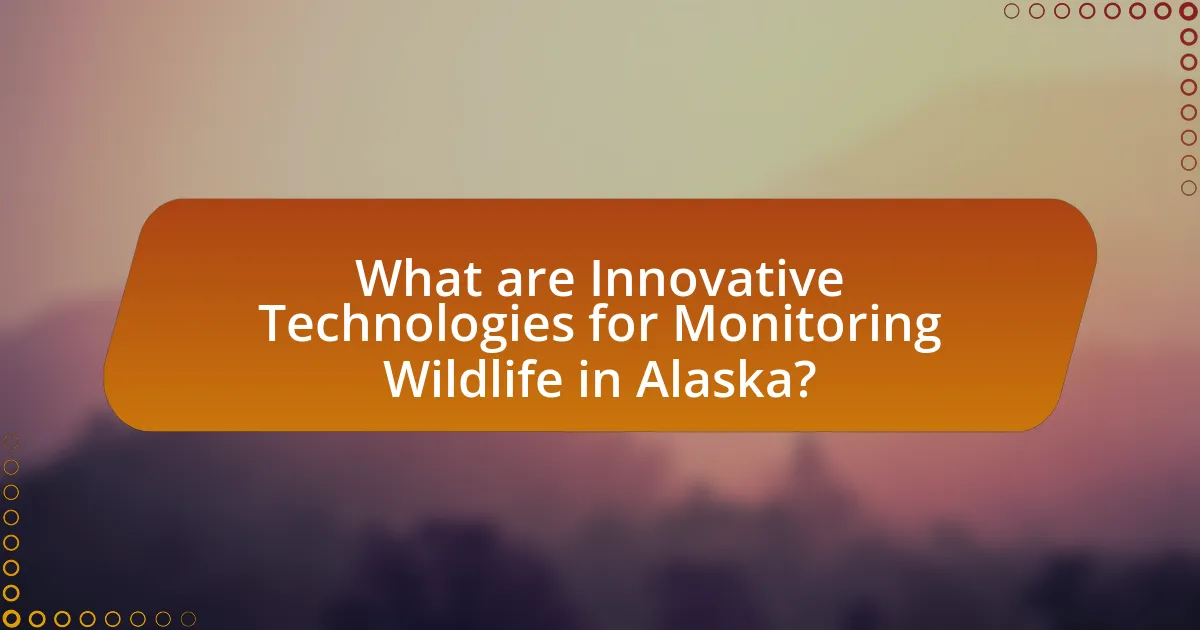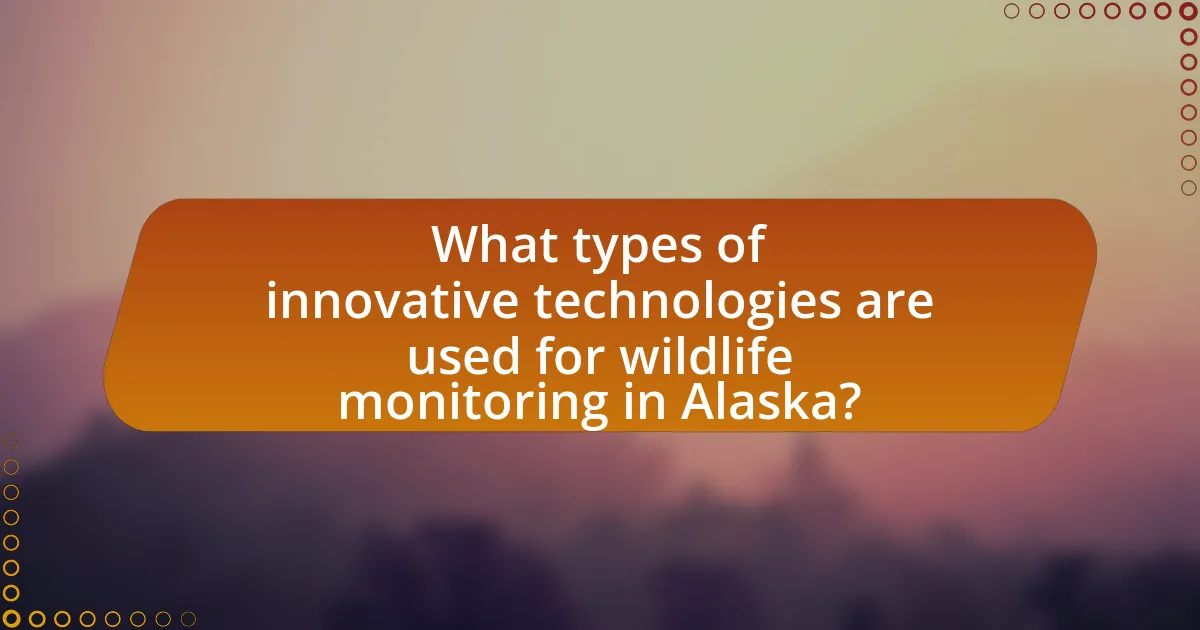Innovative technologies for monitoring wildlife in Alaska encompass satellite tracking, remote sensing, and acoustic monitoring systems. These advancements enable researchers to gather real-time data on animal movements, assess habitat conditions, and detect species presence without direct observation. The article explores how these technologies enhance wildlife monitoring efforts, improve data accuracy, and target specific species such as caribou and moose. It also addresses the ecological challenges Alaska faces, the importance of wildlife monitoring for conservation, and the ethical considerations involved in implementing these technologies. Additionally, it highlights best practices and collaborative efforts that can enhance wildlife monitoring initiatives in the region.

What are Innovative Technologies for Monitoring Wildlife in Alaska?
Innovative technologies for monitoring wildlife in Alaska include satellite tracking, remote sensing, and acoustic monitoring systems. Satellite tracking utilizes GPS collars to provide real-time data on animal movements, enabling researchers to study migration patterns and habitat use. Remote sensing employs aerial imagery and drones to assess habitat conditions and animal populations over large areas, offering insights into ecosystem health. Acoustic monitoring systems capture sounds from wildlife, allowing for the detection of species presence and behavior without direct observation. These technologies enhance conservation efforts by providing accurate data for wildlife management and research initiatives in Alaska.
How do these technologies enhance wildlife monitoring efforts?
Innovative technologies enhance wildlife monitoring efforts by providing real-time data collection and analysis capabilities. For instance, the use of GPS collars allows researchers to track animal movements with high precision, enabling them to gather insights on migration patterns and habitat use. Additionally, remote sensing technologies, such as drones and camera traps, facilitate the monitoring of wildlife populations in hard-to-reach areas, improving the accuracy of population estimates. Studies have shown that these technologies can increase data collection efficiency by up to 50%, allowing for more informed conservation strategies and better management of wildlife resources.
What specific wildlife species are targeted by these technologies?
The specific wildlife species targeted by innovative technologies for monitoring in Alaska include caribou, moose, wolves, and various bird species. These technologies, such as GPS collars and remote sensing, are employed to track movements, assess population dynamics, and study habitat use among these species. For instance, GPS collars have been used extensively on caribou to understand migration patterns, which are crucial for conservation efforts and managing hunting regulations.
How do these technologies improve data accuracy and collection?
Innovative technologies improve data accuracy and collection by utilizing advanced sensors, automated data processing, and real-time analytics. These technologies, such as remote sensing and GPS tracking, enhance precision in wildlife monitoring by providing high-resolution data and reducing human error. For instance, satellite imagery can capture vast areas of land, allowing for accurate habitat assessments, while GPS collars on animals provide precise location data, enabling researchers to track movements and behaviors with minimal disturbance. Studies have shown that the integration of these technologies can increase data reliability by up to 30%, as evidenced by research conducted by the U.S. Geological Survey, which highlights the effectiveness of remote monitoring in reducing data collection biases.
Why is wildlife monitoring important in Alaska?
Wildlife monitoring is crucial in Alaska to ensure the conservation of diverse species and their habitats. The state is home to unique ecosystems and a variety of wildlife, including species that are sensitive to climate change and human activities. Monitoring provides essential data on population dynamics, migration patterns, and habitat use, which are vital for effective management and conservation strategies. For instance, studies have shown that monitoring caribou populations helps inform hunting regulations and habitat protection efforts, ensuring sustainable use of resources. Additionally, tracking changes in wildlife populations can indicate broader environmental shifts, making monitoring a key tool for understanding ecological health in Alaska.
What ecological challenges does Alaska face that necessitate monitoring?
Alaska faces significant ecological challenges that necessitate monitoring, including climate change, habitat loss, and the impact of invasive species. Climate change is leading to rising temperatures and melting permafrost, which disrupts ecosystems and wildlife patterns. Habitat loss due to industrial activities, such as oil extraction and logging, further threatens native species and biodiversity. Additionally, invasive species are altering local ecosystems, outcompeting native flora and fauna. These challenges require ongoing monitoring to assess their impacts and inform conservation strategies, as evidenced by studies indicating that climate change is causing shifts in species distribution and ecosystem dynamics in the region.
How does wildlife monitoring contribute to conservation efforts?
Wildlife monitoring significantly contributes to conservation efforts by providing essential data on species populations, behaviors, and habitats. This data enables conservationists to identify trends, assess the health of ecosystems, and make informed decisions regarding management strategies. For instance, studies have shown that tracking animal movements through GPS collars can reveal critical migration routes, which are vital for habitat protection and restoration initiatives. Additionally, monitoring programs can detect changes in biodiversity, allowing for timely interventions to mitigate threats such as climate change or habitat loss. Overall, effective wildlife monitoring is a cornerstone of successful conservation strategies, ensuring that efforts are targeted and based on empirical evidence.

What types of innovative technologies are used for wildlife monitoring in Alaska?
Innovative technologies used for wildlife monitoring in Alaska include satellite tracking, remote sensing, and acoustic monitoring. Satellite tracking allows researchers to follow animal movements over vast distances, providing data on migration patterns and habitat use. Remote sensing employs aerial imagery and drones to assess wildlife populations and their habitats, enabling efficient data collection across challenging terrains. Acoustic monitoring utilizes sound recording devices to detect animal calls, which helps in studying species presence and behavior. These technologies enhance the understanding of wildlife dynamics in Alaska, supporting conservation efforts and management strategies.
How do remote sensing technologies function in wildlife monitoring?
Remote sensing technologies function in wildlife monitoring by utilizing satellite and aerial imagery to collect data on animal populations, habitats, and behaviors. These technologies enable researchers to analyze large areas quickly and efficiently, providing insights into wildlife distribution and movement patterns. For instance, satellite imagery can track changes in land use and habitat fragmentation, which directly impact wildlife. Additionally, remote sensing can incorporate thermal imaging to detect animal presence and density, enhancing the accuracy of population estimates. Studies have shown that remote sensing can improve wildlife management strategies by providing real-time data, thus facilitating informed decision-making for conservation efforts.
What are the advantages of using drones for wildlife observation?
Drones offer significant advantages for wildlife observation, including enhanced access to remote areas, reduced disturbance to animals, and the ability to collect high-resolution data. Their ability to fly at various altitudes allows researchers to monitor wildlife in habitats that are otherwise difficult to reach, such as rugged terrains or dense forests. Additionally, drones minimize human presence, which can lead to more natural animal behavior during observation. Studies have shown that drones can capture detailed images and videos, providing valuable insights into animal populations and behaviors without the need for intrusive methods. For instance, a study published in the journal “Remote Sensing” demonstrated that drones could effectively monitor the population dynamics of caribou in Alaska, showcasing their utility in wildlife management and conservation efforts.
How does satellite imagery aid in tracking animal movements?
Satellite imagery aids in tracking animal movements by providing high-resolution, real-time data on animal locations and behaviors across vast landscapes. This technology allows researchers to monitor migration patterns, habitat use, and population dynamics of wildlife in Alaska, where traditional tracking methods may be impractical due to the challenging terrain. For instance, studies have shown that satellite tracking of caribou herds has revealed critical migration routes and seasonal habitat preferences, enabling better conservation strategies. The accuracy of satellite imagery, often enhanced by GPS technology, ensures that researchers can collect precise data, which is essential for understanding the ecological impacts of climate change and human activities on wildlife.
What role do camera traps play in wildlife monitoring?
Camera traps play a crucial role in wildlife monitoring by providing a non-invasive method to capture images and videos of animals in their natural habitats. These devices enable researchers to gather data on species presence, behavior, and population dynamics without disturbing the wildlife. Studies have shown that camera traps can effectively monitor elusive and nocturnal species, offering insights into biodiversity and ecosystem health. For instance, a study published in the journal “Ecological Applications” demonstrated that camera traps increased detection rates of various species, allowing for more accurate assessments of wildlife populations in Alaska.
How do camera traps capture data on animal behavior?
Camera traps capture data on animal behavior by using motion sensors to detect movement and automatically photograph or record video of animals in their natural habitat. These devices are equipped with infrared sensors that trigger when an animal passes by, allowing researchers to collect information on species presence, activity patterns, and interactions without human interference. Studies have shown that camera traps can effectively monitor wildlife populations and behaviors, providing valuable data for conservation efforts and ecological research. For example, a study published in the journal “Ecological Applications” demonstrated that camera traps significantly improved the accuracy of wildlife population estimates compared to traditional survey methods.
What are the limitations of using camera traps in remote areas?
Camera traps in remote areas face several limitations, including accessibility challenges, battery life constraints, and potential for equipment damage. Accessibility issues arise due to difficult terrain and long distances, making it hard to install and maintain the traps. Battery life is often limited, especially in extreme weather conditions, which can lead to gaps in data collection. Additionally, remote locations may expose camera traps to wildlife interference or environmental factors, resulting in equipment damage or loss. These limitations can hinder the effectiveness of wildlife monitoring efforts in such regions.

What are the challenges associated with implementing these technologies in Alaska?
Implementing innovative technologies for monitoring wildlife in Alaska faces several challenges, including harsh environmental conditions, logistical difficulties, and high costs. The extreme weather, characterized by low temperatures and heavy snowfall, can hinder the deployment and maintenance of technological equipment. Additionally, Alaska’s vast and remote landscapes complicate logistics, making it difficult to transport and install monitoring devices in isolated areas. The financial burden is significant, as funding for advanced technologies often requires substantial investment, which may not be readily available. These factors collectively impede the effective implementation of wildlife monitoring technologies in the region.
How do environmental conditions affect technology deployment?
Environmental conditions significantly influence technology deployment by determining the feasibility and effectiveness of various technologies in specific settings. For instance, in Alaska, extreme weather conditions such as low temperatures, heavy snowfall, and harsh winds can hinder the operation of electronic devices used for wildlife monitoring. Technologies like GPS collars and remote cameras may require specialized materials and designs to withstand these conditions, as evidenced by studies showing that equipment failure rates increase in severe climates. Additionally, environmental factors such as terrain and accessibility impact the deployment of monitoring technologies, necessitating adaptations in design and installation methods to ensure reliable data collection.
What logistical issues arise when using innovative technologies in remote locations?
Logistical issues that arise when using innovative technologies in remote locations include limited infrastructure, challenging transportation, and difficulties in maintenance and support. Limited infrastructure often results in inadequate power supply and internet connectivity, which are essential for operating advanced technologies. Challenging transportation can hinder the delivery of equipment and personnel, as remote areas may lack reliable roads or access routes. Additionally, maintenance and support become problematic due to the isolation, making it hard to quickly address technical failures or perform routine upkeep. These factors collectively complicate the implementation and effectiveness of innovative technologies in wildlife monitoring efforts in Alaska.
How can data management be a challenge in wildlife monitoring?
Data management poses significant challenges in wildlife monitoring due to the vast amounts of data collected from various sources, including GPS collars, camera traps, and environmental sensors. The integration and analysis of this diverse data can be complex, as different formats and standards may hinder effective data consolidation. For instance, a study by the U.S. Geological Survey highlights that inconsistent data formats can lead to difficulties in data sharing and collaboration among researchers, ultimately affecting the accuracy of wildlife population assessments and conservation strategies. Additionally, the need for real-time data processing and storage solutions increases the demand for advanced technological infrastructure, which may not be readily available in remote areas like Alaska.
What ethical considerations must be taken into account?
Ethical considerations in monitoring wildlife in Alaska include the impact on animal behavior, privacy concerns, and the potential for data misuse. The deployment of innovative technologies, such as drones and camera traps, can alter natural behaviors of wildlife, leading to stress or displacement. Additionally, the collection of data may inadvertently infringe on the privacy of local communities or indigenous peoples, raising concerns about consent and ownership of information. Furthermore, the risk of data being misused for purposes other than conservation, such as poaching or commercial exploitation, necessitates strict guidelines and oversight. These considerations are crucial to ensure that wildlife monitoring efforts are conducted responsibly and ethically.
How does wildlife monitoring impact animal behavior and habitats?
Wildlife monitoring significantly impacts animal behavior and habitats by providing critical data that informs conservation strategies and management practices. For instance, tracking animal movements through GPS collars allows researchers to understand migration patterns, habitat use, and social interactions, which can lead to more effective habitat protection measures. Studies have shown that monitoring can alter animal behavior; for example, animals may change their foraging habits or avoid certain areas due to increased human activity associated with monitoring efforts. Additionally, data collected from wildlife monitoring can reveal habitat degradation or changes in ecosystem dynamics, prompting timely interventions to preserve biodiversity.
What measures can be taken to minimize disturbance to wildlife?
To minimize disturbance to wildlife, implementing measures such as establishing buffer zones, using non-invasive monitoring technologies, and scheduling activities during non-sensitive periods is essential. Buffer zones around critical habitats reduce human-wildlife interactions, while non-invasive technologies like remote cameras and drones allow for observation without direct contact. Research indicates that minimizing human presence during breeding and migration seasons significantly lowers stress levels in wildlife, thereby enhancing their survival and reproductive success.
What best practices should be followed for effective wildlife monitoring in Alaska?
Effective wildlife monitoring in Alaska requires the integration of advanced technologies, community involvement, and adherence to ethical standards. Utilizing GPS tracking collars and remote sensing technologies enhances data accuracy and allows for real-time monitoring of animal movements and behaviors. Engaging local communities in monitoring efforts fosters collaboration and ensures that traditional ecological knowledge is incorporated, which can improve the understanding of wildlife patterns. Additionally, following ethical guidelines, such as minimizing human disturbance and ensuring animal welfare, is crucial for maintaining the integrity of wildlife populations. These practices are supported by studies indicating that technology-driven approaches significantly improve data collection efficiency and accuracy in remote and challenging environments like Alaska.
How can researchers ensure the reliability of collected data?
Researchers can ensure the reliability of collected data by implementing standardized data collection protocols and utilizing validated measurement tools. Standardized protocols minimize variability by providing clear guidelines for data collection, which helps maintain consistency across different researchers and study sites. For instance, using GPS collars with established accuracy rates for tracking wildlife movements ensures that the data collected is precise and comparable. Additionally, employing statistical methods such as reliability analysis can quantify the consistency of the data over time, further validating its reliability. Studies have shown that adherence to these practices significantly enhances the credibility of research findings in wildlife monitoring, as evidenced by the successful application of these methods in various ecological studies.
What collaborative efforts can enhance wildlife monitoring initiatives?
Collaborative efforts that can enhance wildlife monitoring initiatives include partnerships between governmental agencies, non-profit organizations, and local communities. These collaborations facilitate resource sharing, expertise exchange, and data integration, which are crucial for effective wildlife management. For instance, the Alaska Department of Fish and Game collaborates with organizations like the Wildlife Conservation Society to implement advanced tracking technologies, such as GPS collars and remote sensing, which improve data accuracy and monitoring efficiency. Additionally, engaging local communities in data collection and reporting fosters a sense of stewardship and increases the volume of information available for wildlife assessments. This multi-stakeholder approach has been shown to lead to more comprehensive and sustainable wildlife monitoring outcomes.


